HOW DOES AN
EARTH DIPOLE WORK?
By Renato
Romero
Although in internet
many materials can be found about earth dipoles used as antennas, to
understand how they works can be very complicated. With what principle
does it work? What is the frequency range where it can be used with
good profit? What about reception diagram? What's the signal component
received with an earth dipole: electric field or magnetic filed? With
what polarization?
And still: why some
signals
present on air (as Schumann resonaces) can't be received with earth
probes?
And why some signals received with earth dipole are not receivable on
air?
In this article we will search some answer to these questions.
DEFINITIONS
AND APPLICATIONS
With "earth dipole" we meana reception system
composed by two earth connections, spaced each other by some tens
meters, used as receiving or transmitting antenna. They are used in
different applications, professional, military and for hobby:
- as transmitting antenna for 82 Hz and 76 Hz
signals,
directed to the submarine in immersion (during missions)
- for earthquake radio precursors monitoring, see
the ELFRAD group activity
- by some radioamators for the 137 kHz band
reception
- by some SWL for medium wave and long wave
broadcast
monitoring
- by geologist for geophysical prospecting and
underground tomography
- from the archeologists, for ruins location finding
In this script we will limit our study to the
earth
dipole used as receiving antenna below 22 kHz.
SOME
RECEPTIONS
COMPARISON
A first wide band test
shows
very similar results obtained using an earth dipole compared to a
stylus reception.
 |
|
VLF
Range
The picture beside shows
some seconds
of nighttime reception in a 1 Hz to 22 kHz frequency range.
The above part has been received with an 7m
vertical stylus, placed 50m from my home in the garden, far from
electric lines. Alpha signals, RTTY and statics are clear. Below 2 kHz
some hum noise.
|
Part below shows the same signal received with a
25m earth dipole, E-W oriented, and installed in the same place of the
stylus. Signals are very similar. Hum noise is a little stronger than
before but substantially two pictures show the same signals.
But going down in
frequency
some differences begin to appear:
 |
|
VF
(Voice Frequency) Range
In the part above (received with stylus) many
long
distance statics (the ones below 1 kHz) appear in the spectrogram. They
extend their components down to few Hz.
But in the part below (coming from earth
dipole)
they seem to become more and more weak going down in frequency. The
long
distance statics have almost disappeared under the 500 Hz.
|
Reception landscape appears clear and complete in the next spectrograms:
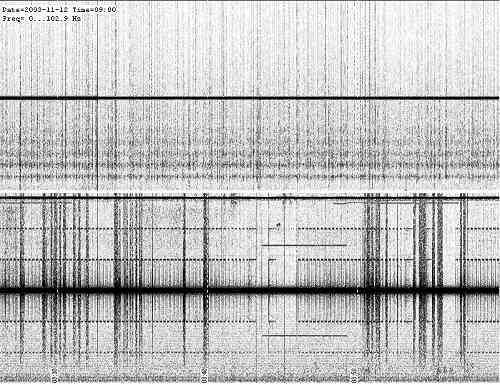 |
|
ELF/ULF Range
Where it is shown a comparison between
the two different reception system in the frequency range from 0 to 100
Hz. Here differences appeared light in the voice frequency range (300
Hz - 3 kHz) become substantial.
In the part above we can see Schumann
resonaces,
50 Hz hum noise tone and some statics.
|
In the part below 50 Hz tone appears stronger
(with a 100 Hz tone, invisible with stylus reception), different wide
band bursts are present, many tones mirrored to 50 Hz signal, an hiss
below 15 Hz and no evidence of Schumann Resonances.
How to explain this marked difference of
behavior
in the different ranges of frequency?
SOIL
IMPEDANCE
MEASUREMENTS
Some preceding experiences demonstrate me that an
earth dipole is not so easy to understand. Following the intention to
discover how it receives signals present on air, I decided to measure
the impedance of the soil, seen by two earth probe 55m meters far each
other.
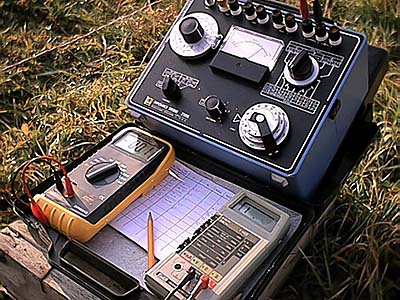 |
|
First tentative was with a
bridge measuring instrument: an ESI 250. It can measure very low
inductance value, also with Q factor very low, below 1, injecting a low
sinusoidal current of 1 kHz.
But results by measurements were too
strange: sometimes
I saw between the two stakes an inductance of 50 mH (an incredible
value,
too high), and sometimes the same measure repeated 30 minutes later
gave
values of 20 or 30 mH.
And even more strange: changing the dipole
direction
the inductance value changes. A spectrogram analysis of the signal used
by bridge for its null gave me the answer.
|
The reason was in the ground: the 50 Hz hum
noise with all harmonics components falses the measures, and the bridge
finds its null not on his real signal but on the 50 Hz 20th harmonics:
the 1000 Hz coming from electric line. It changes in level in the time
and change in direction with the dipole: values change consequently.
Table of tests is not reported here, because
results
are with any meaning.
After a short consultation with Wolfgang
(DL4YHF) I decided to change this measurements system.
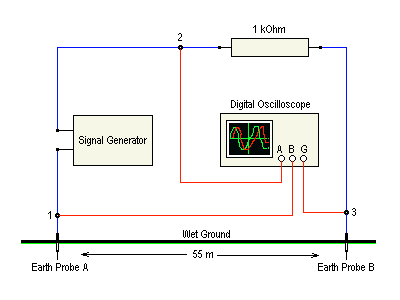 |
|
Picture beside shows the new
measurement
setup, composed by 2 channels digital oscilloscope, a signal generator
and a 1 kOhm resistor.
Signal generator injects its current
in the ground by earth probe, passing through the 1 kOhm resistance. First channel
of oscilloscope reads voltage on the 1 kOhm
resistor (V2-3), second channel on the earth dipole (V1-3). Tests were made at different frequencies, starting from
50 Hz to 100 kHz. For every frequency was recorded the two voltage values
and the delta time from the two signals (Dt).
|
Both the instruments (signal generator and
digital oscilloscope) where battery maintained, to avoid ground loops
and have floating measurements points done.
All data were tabulated in an excel table (first
5 columns). The other 8 columns were used with mathematical formulas to
calculate values for every frequency of:
Idipole
Z
Phase
Xc
or XL
R
Q
C or L |
=
=
=
=
=
=
= |
Current in the
earth dipole
Impedance module of the
earth
dipole
Grade and radiant
between
voltage and current in the earth dipole
Reactive component of
impedance
Active component of the
impedance
Q factor
Value of the reactive
component
in the ground |
Here below the results:

Results was for me a surprise: current was not
in
late but in advance respect the applied voltage. The
graph shows clearly the results:
 |
|
Looking into the earth stakes
we don't see an inductance: we see a capacitance!
Light blue curve shows this phenomenon.
And capacitance value grows going down in frequencies. At 50 Hz we can
observe a big value of 60 uF. Here a reason because the virtual
underground loop can not work below 2 kHz: weak inductance value can be
nulled by this underground capacitance.
|
We can also observe an increasing of the
capacitive
reactance going up in frequency and a decreasing of the resistive
values
at higher frequencies.
But how can be possible an underground
capacitance
if current paths describes a loop? Where is the origin of this new
component?
FREQUENCY
DEPENDENT
RESISTIVITY AND INDUCED POLARIZATION
A complete explanation of this phenomenon can be
found in a document of University of
California of BERKELEY, where the "induced polarization" phenomenon
(this is the correct name) is explained. This document observes that
the measured resistivity of a soil is function of the frequency in the
range from 0.1 mHz to 10 kHz, and that voltage and current are not in
phase especially if soil contains clay (like in my measures).
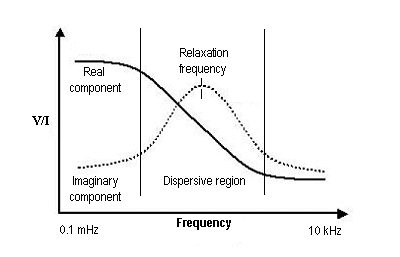 |
|
Picture (taken
from that site) shows the real component where current is in phase with
applied voltage (resistance) and the imaginary component where the
current is 90 degrees out of phase, in squared (capacitance). Here, as
in the graph above we can see that the resistivity decreases with
increasing frequency, and that the imaginary component with his maximum
at fr: the relaxation frequency. The range where we can see the maximum
change of resistivity and where imaginary component maximizes is called
dispersive region. |
Soil electrical response suggests an energy
storage mechanism like in a capacitor. Then, the equivalent circuit of
the soil can be synthesized as the following circuit:
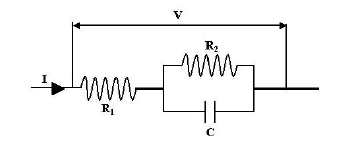 |
|
At DC the
capacitor is
an open circuit and all the current passes through the sum of R1 and
R2,
developing a voltage Vp = I (R1 + R2). As the frequency increases,
current
can flow through the capacitor, which decreases the overall resistance.
Finally at high frequency the current is effectively short circuited by
the capacitor and the voltage developed is simply I R1. |
Between the DC and high frequency limits, the
voltage across the capacitor is phase shifted 90° from the current
and so adds an imaginary component to the total voltage measured across
the circuit, which peaks midway between the low and high frequency
asymptotes. Thus, we see that this circuit faithfully reproduces the
key features observed in the measurement
Capacitance is basically a ionic separation
under the application of an electric field of free charges, ions, that
move through the fluid. How can we imagine then, an earth dipole as
receiving antenna? The following models try to give a possible
explanation.
THE
UNDERGROUND
LOOP MODEL
The first model easy to think corresponds to an
underground loop. Following the current paths through the earth
(includes by two earth probe with a DC voltage applied), we can observe
an underground current loop. Loop model can also explain why
sensitivity decreases at low frequency, as we can see in the ELF/ULF
spectrogram above.
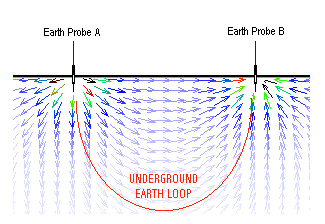 |
|
Virtual Loop dimensions are similar to a
square loop. Then, for a 25m earth dipole we can suppose an underground
virtual square loop of 25m x 4 = 100m.
DC resistance really measured by the two
stakes
was about 500 Ohm. Using a software simulation of G4FGQ (rjeloop3.exe)
we can calculate the loop inductance and the wire equivalent diameter.
For a 25m earth dipole of the picture, estimated inductance is 0.26 mH
and the equivalent loop results composed by a wire of 0.06 mm diameter
(more little than a hair).
|
(A fast loop test made by one square turn 25m
side
horizontally placed was measured, obtaining 0.29 mH. Then the 0.26 mH
value
above can be considered valid)
Using the formula
F = XL
/ (2 x 3.14 x L)
we can calculate the low frequency corner, where
the underground loop stops being an antenna, and the resistance
effect
begins to prevail and to degrade the signal reception (were the Q
factor
goes down under 1). For our example it results to be:
F = 500 / (2
x 3.14 x 0.00026) = 306 kHz
In fact if we use the earth dipole as receiving
antenna for medium waves we obtain excellent results. VLF beacon are
strong
and clear and the dipoles appear to be also directive. But at 1 kHz we
have as inductive reactance:
XL
= 2 x 3.14 x F x L = 2 x 3.14 x 1000 x 0.00026 = 1.63 Ohm
Then a Q factor of:
Q = XL / R =
1.63 / 500 = 0.0032 (a
disaster)
Mathematical calculations explain why this model
works bad at low frequencies: by formulas the underground loop should
be able to receive effectively very strong signals only, using the
magnetic component. And the situation worse more always
decreasing the frequency.
 |
|
This model can be validate also from
another calculation:
Using another program of G4FGQ
(soilskin.exe) we
can calculate how RF signal penetrates in the ground, then to verify if
buried loop model is possible.
As we can observe from the table beside,
below 10 kHz this model can exist in any kind of soil.
|
I wanted then, to verify it with an "on field"
test. First of all I built a big horizontal loop, composed by an 1 turn square
loop (25m side) with an 500 Ohm resistance in series, to simulate the underground
loop. Nearby to it I placed a 3 turn square horizontal loop (3 m side), used
as loop transmitting test. A signal at 0 dBm was injected in the little loop
at 5 kHz, and in a big loop a signal of -61 dB was read.
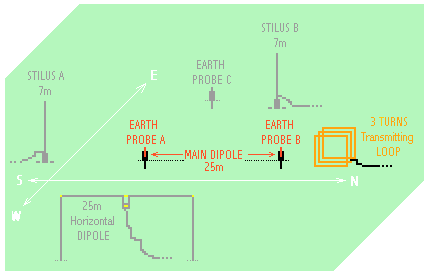 |
|
After that I passed to the set-up shows beside: a 5W 5 kHz signal was sent to a vertical
transmitting loop (3 turns of square loop, 2m side) aligned to the main
earth dipole and near to the earth probe B (as in the past horizontal
experiment). There were no evidence of signal under the
background noise normally received by earth dipole: magnetic signal
sent by 3m square loop was received with horizontal 25m square loop,
but magnetic signal emitted by the same loop in vertical position was
not receivable with earth dipole. |
Of course the distance
between transmitter and receiver (compared to the wavelength) is so small that
we are in the reactive near-field, where very strange things do happen. There
is mostly inductive coupling like in a transformer, but there may be also capacitive
coupling (even from such a TX loop) which cannot be seen by the earth loop.
I always imagined my earth dipole as a deep invisible buried
loop, and now I discover probably it doesn't works like this. A possible cause
can be the inducted polarization: capacitance can neutralize the inducted component
and the signal that came through that.
Or soil skin deep can be modified by underground
stratum: my garden is placed in a wet plane near mountains, with yellow
clay just few centimeters under the green surface; similar soils are
normally rich of water immediately under the clay layer, and water is
an high resistive material. Then the "earth dipole antenna cube" became
an "earth dipole antenna disk" and currents from a probe to the other
don't penetrates in deep as in the picture first, but run just below
the surface in a clay layer, giving a strong inducted polarization
effect and neutralizing the loop effect.
But if buried loop is not a valid model, how can
we consider the earth dipole as an antenna?
EARTH
PROBES
AS HORIZONTAL DIPOLE
Another test was done to verify this hypothesis:
can an earth dipole work as an horizontal dipole? Ground model as a
conductive thin surface can transform two earth probes in an horizontal
electric field sensor?
 |
|
An horizontal dipole, 25 m
long (like
the earth dipole), 7 m above
ground, and about 20 m of distance from
the earth dipole was placed as in the picture. The green dipole was
used
to transmit a signal and the main earth dipole as receiving
antenna.
Like in the transmitting loop experiment
no signal
was detected by earth dipole.
|
Maybe because at this
extremely low distance (considering a wavelength of 60 km or so), there is no
real electromagnetic field radiated from the 25m dipole, there is only some
capacitive coupling between TX and RX (which can be modeled as an EXTREMELY
SMALL coupling capacitor), and this extremely high-impedance-source can be easily
shorted by the soil conductivity. Just a few picofarads of coupling between
generator ("dipole" in air) and detector (earth loop), but shorted with a few
Ohms at the detector. The earth gives a pretty effective short circuit in my
location. Elsewhere, where there is dry sandy ground in some places, things
may look very different.
This strange model was born in my head looking
at the RTTY signal direction, received with a couple of orthogonal earth dipoles.
In a long time observing, they seem to change slightly incoming direction. I
hypothesized that this effect caused by the rotating polarization of coming
signals, especially during the grey line time (during the sunrise and during
the sunset). This experiments demonstrate that an earth dipole doesn't receive
signals in horizontal polarization. Changes of colors in the RDF representation
are probably caused by temperature effect on the electric ground characteristics:
sunrise and sunset are conditions where temperature changes more quickly than
in all hours of the day and of the night.
RECEPTION
BY
SURFACE WAVE
This concept is similar to the one used in a TEM
cell for EMC testing. An electric wave, passing through a conductive
surface, determines a voltage potential between two points of the
surface, if they are aligned to the wave propagation versus.
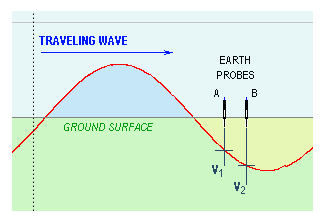 |
|
As in the picture beside, a
signal,
traveling on the ground surface gives a voltage RF signal from A to B
points.
This voltage is proportional to the A-B points alignment with the front
wave direction. At the same time signal captured decreases getting down
in frequency, because voltage difference is proportional to report:
"Earth
Dipole length / Signal Wave length". As we have Earth probe distance as
a constant, signal sensitivity increases with frequency. |
If this concept is true we have for electric
field (using a main dipole of the picture as receiving antenna) the
best reception in North-South path and a frequency response similar to
a vertical loop (emphasize frequency response).
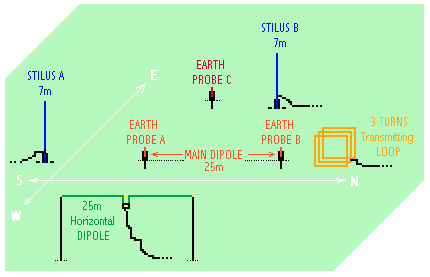 |
|
Another test was
done sending a signal with A and B stylus. They were placed about 20m
from the A-B earth probes. Result was unequivocal: A-B earth dipole
received a strong signal from A stylus and very weak from B stylus.
Next paragraph will show better how the earth dipole works at different
frequencies.
|
Although probably weak component of the underground loop
reception and horizontal dipole may be present, I think this is a better explanation
to the title question: "How does an earth dipole works?".
RECEPTION
BY
VOLTAGE GRADIENT
Last question remains still to solve: both
underground loop and traveling wave models, can't receive signals at
very low frequencies. Frequencies from 1 Hz down to DC are made by
wavelengths up to 1 million of km: a simply earth dipole of 25m can't
detect any difference voltage in a traveling wave. But despite of this,
we can receive many signals below 1 Hz (see at ELFRAD activity).
 |
|
I think this can be a
possible explanation: if we consider a signal source (not too far from
the receiving place) the electric field decreases with a distance from
the source. If two probes are placed aligned to the line field
direction, points A and B are at different voltage V1 and V2.
Signal received is independent from
frequency, because we are reading a signal as a static field. Thanks to
voltage gradient the system can receive down to the DC.
|
But listening to earth probes we can discover a
lot of noise: basically from main network, but also from electrolysis
reaction in the ground. I suppose it's impossible to distinguish below
1 Hz signal coming by air from signals traveling in the ground,
originated by chemical reaction everywhere on the earth surface.
WHITE
NOISE
TEST and TRANSFER FUNCTIONS
By set-up presented above some tests have been
done in a frequency domain. Here below are the results. They can
explain some interesting questions about ELF reception and earth dipole
sensitivity.
Here below a white noise was transmitted by
Stylus
A (see pictures above).
-
The red line shows
the
signal output by the noise generator (a simply sound blaster card was
used).
- The green one shows the sent signal
received by Stylus B (using a flat frequency response preamplifier).
-
Yellow line shows the same signal received by
earth
dipole. Appears clearly an attenuation curve of 6 dB x octave. This
reception
can be read as a confirm of the "traveling wave" model presented above.
- Light blue line shows the noise floor of my
sound blaster card. Since tests are done on field we can see the main
spectrum lines also, to emerge from the noise.
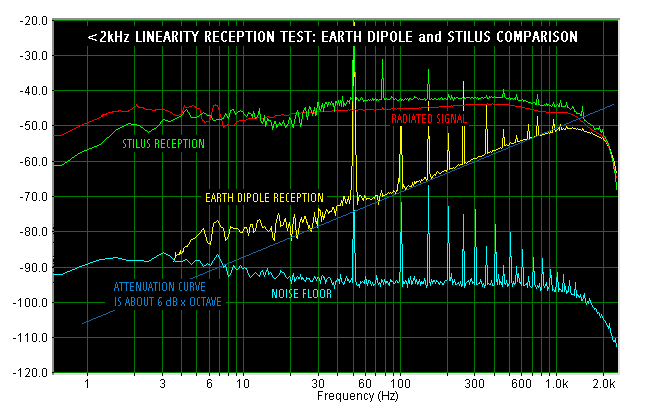
To obviate the limits of the white noise another
test was done with a sweep generator, using the hold mode to determine
the transfer function from the different antenna. This test was done
from
2 Hz to 20 kHz.
- Yellow line reports the level of the signal
sent.
- White line the transfer function from earth
dipole to earth dipole. A signal sent to AB was received by AC earth
dipole; we can observe an excursion of +/- 4dB in the entire frequency
range. Basically a good result, considering that earth dipole are
separated by two transformer to the station and from a couple of
preamplifier.
- Red line shows transfer function from
stylus A to stylus B, also here basically flat.
- The most interesting result comes from an
earth dipole: grey line shows signal sent by stylus A and received by
AB earth dipole; we can see the same frequency emphasis effect. Also
here 50 Hz frequency line appears in the field test
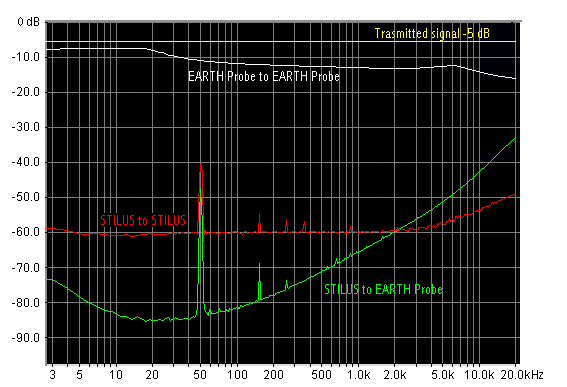
RESULTS
APPLICATIONS
As first result I wanted to apply the
attenuation found curves to the real situation, then, when an earth
dipole is used as receiving antenna. Using as reference the
spectrograms at the beginning of this article, where down to 2 kHz
stylus reception and earth dipole seem to receive same signals, I
crossed the attenuation curves, obtaining this interesting graph:
-
Yellow line shows natural radio signal received
usually
by Marconi T antenna (or by stylus). Strong main noise but clear
Schumann
resonances.
- Red line shows natural radio signal
received by earth dipole. Below 2 kHz an hiss is present down to 3 Hz.
It is not caused by transformers: a 500 Ohm resistance was placed
instead of the earth dipole, obtaining a blue light curve that shows
the receiving system noise floor. Then this noise comes from ground,
probably caused by electro chemical reactions in the ground. The area
below this line is a black zone: no signal is received because drowned
in the noise
- White line is calculated, applying the 6 dB
x Octave curve found above. This represents how the earth dipole
receives natural radio signals below 2 kHz. It's clear: below 2 kHz the
earth dipole can't receive Schumann resonaces because, caused by low
sensitivity of the dipole, they are 20 dB below the electrochemical
noise level
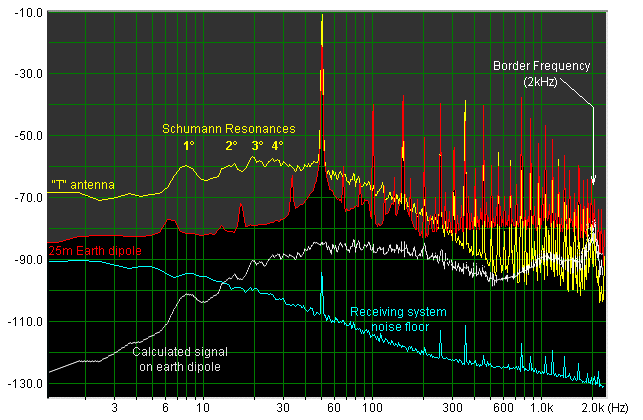
CONCLUSIONS
and ACKNOWLEDGMENTS
Far to discover the entire truth, I hope I have
however helped to understand something more about this simply and cheap
reception system: the earth dipole. I think results can be different
from place to place, from soil to soil: this article can be a starting
point from other similar tests in other places; I hope this.
Thanks to Marco Bruno and Wolfgang Büscher
for technical support, set up suggestion and for demonstrated patience.
Thanks again to Marco Bruno for the lent electronic instruments, coming
from Spin Electronics, and thanks
to Andrea Bertocchi and Michel Andrè for English revision.
Return to the main
index


















